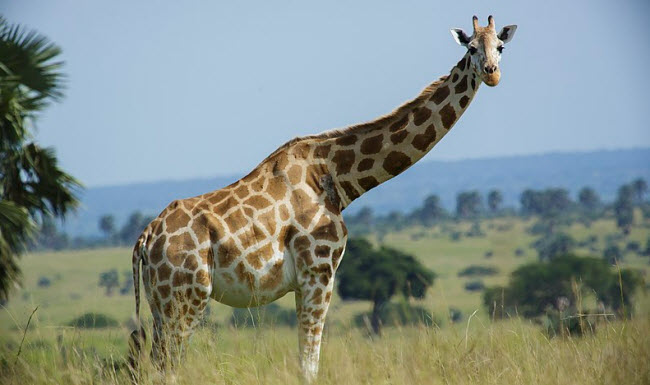The giraffe, a mammalian species native to Africa, ranges from Chad in the north to South Africa in the south, and from Niger in the west to Somalia in the east. It holds the title of the tallest land animal and is the largest ruminant on Earth. Notably, the giraffe’s extraordinarily long neck and legs distinguish it from other animals. These creatures typically inhabit savanna forests, where they find ample food sources in leaves, fruits, and flowers, particularly from acacia trees. These trees have foliage at heights unreachable by most other herbivores, making them ideal for giraffes. Giraffes are generally peaceful animals, often falling prey to predators like lions, leopards, spotted hyenas, and African wild dogs
Throughout history, giraffes have fascinated many cultures due to their unique appearance. They have been frequently depicted in paintings, books, and cartoons. Recently, the International Union for Conservation of Nature (IUCN) classified the giraffe as a vulnerable species, as they have been extirpated from many of their historical habitats. As of 2016, it is estimated that around 97,500 giraffes remain in the wild, with over 1,600 living in zoos worldwide.
Physical Characteristics and Adaptations
Giraffes are the tallest land animals, with the ability to peer into a second-story window without even standing on their toes. An adult giraffe’s neck, which can be as long as 1.8 meters, weighs approximately 272 kilograms. Their legs are also about 1.8 meters long, with the hind legs appearing shorter but actually being nearly the same length as the front legs. The giraffe’s heart is about 0.6 meters in length and weighs around 11 kilograms, and their lungs can hold up to 55 liters of air. Giraffes have a small hump on their back and a coat patterned with spots similar to a leopard’s. This unique coat pattern led people to historically refer to them as “camel-leopards,” believing them to be a cross between a camel and a leopard.
A genetic study published in Current Biology has identified four distinct giraffe species, with one currently recognized species having nine subspecies. These subspecies have varying coat patterns and colors, ranging from light brown to almost black, depending on their habitat and diet. For example, the Masai giraffe found in Kenya has oak leaf-like patterns, while the Rothschild giraffe in Uganda is distinguished by large brown patches separated by thick white lines. The reticulated giraffe in northern Kenya has a darker coat with a network of narrow white lines.
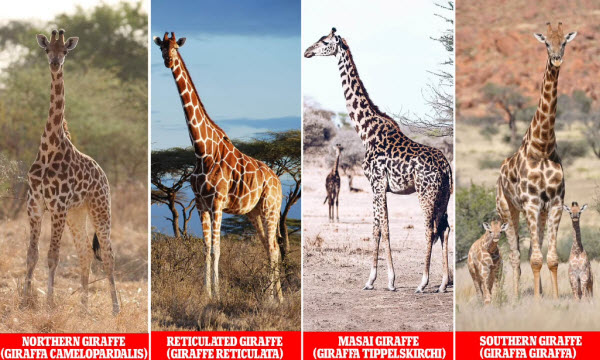
Despite their long necks, giraffes have only seven neck vertebrae, the same number as humans, though each vertebra can be up to 25.4 centimeters long. Both male and female giraffes possess distinctive hair-covered ossicones on their heads. Males use these in necking battles, where they swing their necks at each other. As males mature, calcium deposits develop on their skulls to protect them during these battles, sometimes giving the appearance of having three to five horns.
Behavior and Survival Strategies
Giraffes, due to their large size, are unable to hide from predators. Therefore, they typically stay in tight-knit groups, making it difficult for predators to approach. Besides humans, giraffes are preyed upon by lions, leopards, hyenas, and crocodiles. Giraffes are aided by their speed, unique movement, and body shape in escaping from predators if needed. If a confrontation with a predator is unavoidable, giraffes defend themselves by delivering powerful, karate-like kicks. They have a distinctive gait, moving their front and rear legs on one side of the body forward together, followed by the legs on the other side, which allows them to run at speeds of up to 56 kilometers per hour over short distances.
Interestingly, giraffes only require 5 to 30 minutes of sleep per day, often taking quick naps that last just one or two minutes each time. While they can rest while standing, they sometimes lie down with their head resting on their rump, a vulnerable position that necessitates one member of the group to remain alert for potential threats.
Contrary to popular belief, giraffes do produce sounds, including roars, snorts, hisses, and hums, although they rarely do so. They snort when alarmed, serving as an early warning to other giraffes and wildlife in the savanna. Studies suggest that giraffe vocalizations and their frequencies are often below the range of human hearing, possibly used for long-distance communication.
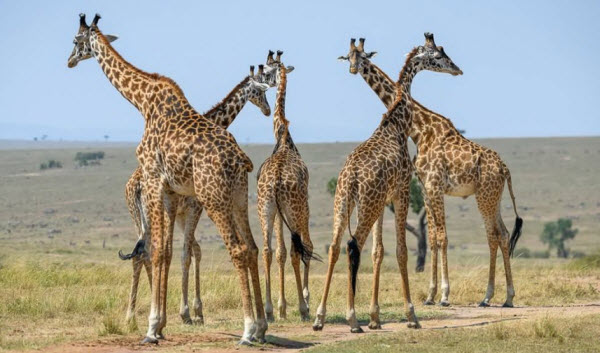
Ecological Role and Conservation
In contrast to their prominent display in zoos, where giraffes are often a main attraction, their coat patterns serve as effective camouflage in their natural African habitats, blending seamlessly with the shadows and leaves. Giraffes are well-adapted to living in open African plains filled with trees, competing with other African herbivores for grass and small plants. Given their large size, giraffes require substantial amounts of food, consuming up to 34 kilograms of foliage daily. Thus, they spend most of their day eating, often consuming acacia leaves, which are their favorite. These leaves have long thorns that deter most herbivores, but giraffes use their 46-centimeter-long tongues and prehensile lips to navigate around the thorns. It is believed that the dark color of their tongues helps protect them from sunburn as they reach for these leaves. They also have thick, sticky saliva that protects them from any thorns they might accidentally ingest.
Due to their diet of acacia leaves, giraffes can go for extended periods without drinking water, as these leaves contain plenty of moisture. However, when thirsty, giraffes must bend down a great distance to drink from a lake or stream, a position that makes them vulnerable to predators like crocodiles. To mitigate this risk, giraffes often visit water holes in groups, taking turns watching for predators. If water is readily available, they can drink up to 38 liters daily.
Reproduction and Early Life
When a giraffe calf is born, it enters the world feet-first, followed by the head, neck, and shoulders. The umbilical cord, approximately one meter long, breaks midway through birth, allowing the newborn to drop to the ground, which, although a considerable fall, does not harm the calf. Instead, this fall encourages the calf to take a deep breath, marking the start of its life. Within an hour, the calf can stand and walk, and by a week old, it begins sampling vegetation. As the calf grows, the mother often leaves it with other calves in a nursery under the watchful eye of one of the mothers while the others go off to feed and socialize. In the nursery, calves develop physical and social skills by playing with each other, exploring their surroundings throughout the day under the vigilant eye of the designated “babysitter.” Young giraffes can start eating leaves at about four months old but continue nursing until they are six to nine months old.
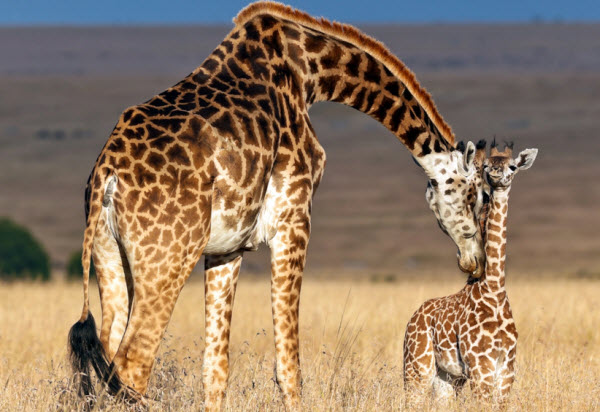
Threats and Conservation Efforts
Giraffe populations are slowly declining in many African countries due to habitat loss and overgrazing by livestock. The future of giraffes depends on the quality of the remaining habitat. The West African or Nigerian giraffe, a subspecies, is considered endangered, while the Ugandan or Rothschild giraffe is nearly threatened. Historically found in areas of western Kenya, Uganda, and South Sudan, the Ugandan giraffe has been almost entirely eradicated from most of its previous range, now existing in a few isolated locations in Kenya and Uganda. The Nigerian giraffe is found only in a single area in Niger and is considered one of the rarest giraffes. The reticulated giraffe is expected to face an 80 percent risk of extinction within just ten years, primarily due to poaching by humans who hunt them for their meat and tail hair. Fortunately, Kenya has recently initiated a giraffe conservation program for the three subspecies found in the country.
Identification Card
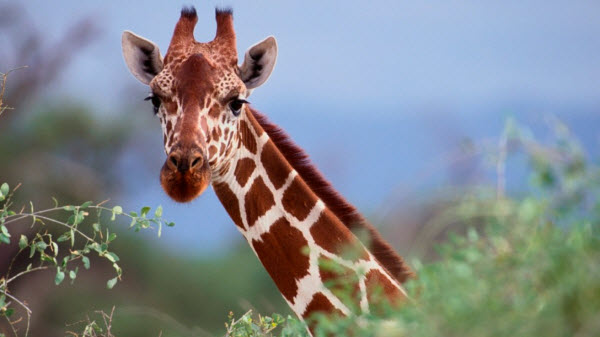
- Class: Mammals
- Order: Artiodactyla
- Family: Giraffidae
- Species: Giraffa camelopardalis
- Lifespan: 15 to 20 years
- Gestation Period: 14 months
- Birth Weight: 45 to 100 kg
- Maturity: 3 to 5 years
- Height: Females up to 4.3 meters, males up to 5.5 meters
- Weight: Females around 680 kg, males up to 1.4 tons
Quick Facts about Giraffes
- The size of a giraffe’s heel is about the size of a dinner plate, measuring 30.5 centimeters.
- Giraffes can run at a maximum speed of 56 kilometers per hour.
- A giraffe’s eyes are about the size of golf balls.
- Giraffe calves grow at a rate of 2.54 centimeters per day during their first week of life.
